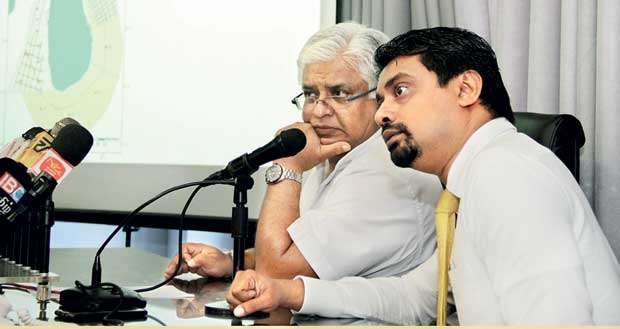Reply To:
Name - Reply Comment

From left: Petroleum Resources Development Minister Arjuna Ranatunga and PRDS Director General Vajira Dassanayake
Pic by Pradeep Dilrukshana
By Nishel Fernando
The Petroleum Resources Development Ministry will call international tenders shortly for a 2,924 square kilometre offshore M2 block in the Mannar Basin to develop the two oil and gas discoveries and for further explorations.
Talking to reporters in Colombo, yesterday, Petroleum Resources Development Minister Arjuna Ranatunga along with Petroleum Resources Development Secretariat (PRDS) Director General Vajira Dassanayake revealed that the third major licensing round is scheduled to be called in August, next year, for exploration and development of the remaining oil and gas blocks in the Mannar and Cauvery Basins.
In addition, in several weeks, the PRDS has also planned to call for a mini bid round to explore the M1 and C1 blocks.
To develop the M2 block, the PRDS has estimated US $ 750 million would be required, which includes the expenses for pipelines and appraisal programmes. Dassanayake noted that the interested parties would have a four-month period to submit their proposals along with their development plans. According to him, the Dorado natural gas deposit discovered by India’s Cairn in 2011 is sufficient to power the 300MW LNG power plant for 20 years.
Dassanayake noted that the tender board was scheduled to meet yesterday to finalise and approve the final tender proposal.
Ranatunga expects that from the Dorado deposit, Sri Lanka would be able to start producing LNG from 2023 onwards.
Eastern Echo Holdings PLC, a fully-owned subsidiary of the world’s largest US-based oilfield services company Schlumberger, was awarded a multi-client contract this May to conduct seismic surveys for data acquisition for oil and gas exploration around Sri Lanka, on a non-exclusive basis; the government is to own the data.
Schlumberger recently completed the largest 2D seismic survey for data acquisition off the eastern coast of the country, in the JS5 and JS6 blocks, after securing US $ 9 million funds from TOTAL.
The PRDS is also expected to sign an agreement with TOTAL and the Norwegian multinational energy company Equinor, in the first week of December, to further advance the oil exploration efforts in the ultra-deep waters off the east coast, subject to Cabinet approval.
“If the results are positive of the 2D seismic survey in the JS5 and JS6 blocks, they will go for 3D seismic surveys. Thereafter, they might go for exploratory drilling. Depending on the results of the 2D seismic survey, they will either offer a product sharing contract or they will relinquish the blocks,” Dassanayake said.
He noted that TOTAL has decided to invite Equinor as a partner to bring in more funds to the exploration efforts, as the drilling activities in the ultra-deep water are very expensive.
The acquired data by Schlumberger will be processed for a duration of five months at the Schlumberger Technical Centre located in Kuala Lumpur. Thereafter, the geo-science team of the PRDS and the technical team of TOTAL in Singapore would interpret the processed data collaboratively.
In addition, Schlumberger has also conducted limited 2D seismic surveys in two blocks in the Cauvery Basin (C4 and C5) and the JS1 to JS4 blocks off the eastern coast, which were funded by various oil and gas companies.
Dassanayake highlighted that data acquisition from the Cauvery Basin has been done after 35 years of absence of any activities.
BGP Pioneer, a survey vessel sailing under the flag of Panama, is facilitating the process of data acquisition. The vessel, which was docked at the Port of Colombo yesterday, was expected to be dispatched from Colombo to Mannar to conduct 2D seismic data acquisition in Mannar.
“We want to acquire some more data on the Mannar Basin using the latest technologies, in order to correlate the existing data set with new data sets to have a better interpretation of both data sets,” Dassanayake noted.
The PRDS has also planned to acquire airborne gravity, gravity gradiometry and magnetic data in the Cauvery and Mannar Basins on a multi-client basis to determine which blocks are commercially viable for exploration.